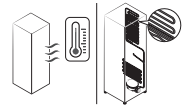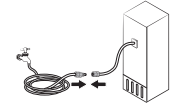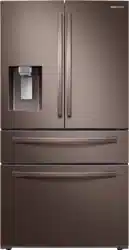Documents: Go to download!
User Manual
- User Manual - (English, French, Spanish)
- Energy Guide - (English)
- Specification - (English)
- Spec Sheet (web) - (English)
- Installation
- Operations
- Maintainance
- Troubleshooting
Table of contents
User Manual Samsung Refrigerator
Installation
Refrigerator at a glance
Type A
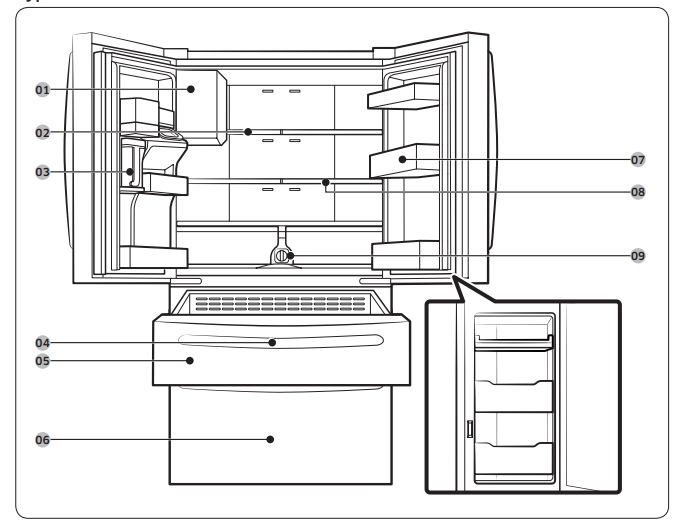
Type B
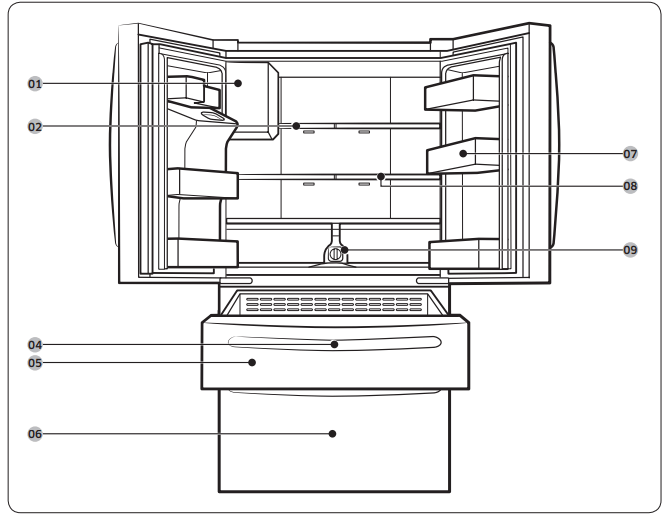
01 Auto Ice Maker
02 1-Step Foldable Shelf
03 Water tank (Auto Water Fill)
04 Main panel (on the FlexZone™ handle) 05 FlexZone™
06 Freezer
07 Door bins
08 2-Step Foldable Shel
09 Water filter
Door bins
Your refrigerator ships with door bins of different types and sizes. If the door bins for your refrigerator were packaged separately, use the figure below to help you position the bins properly
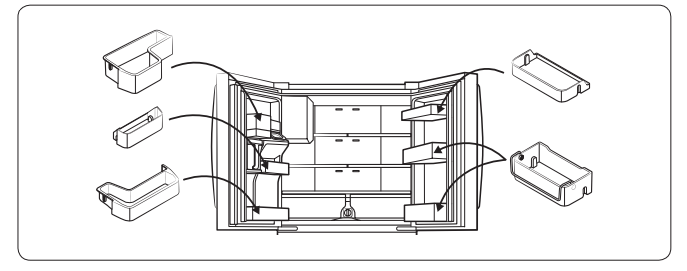
Step-by-step installation
STEP 1 Select a site
Select a site that:
• Has a solid, level surface without carpeting or flooring that may obstruct ventilation
• Is away from direct sunlight
• Has adequate room for opening and closing the door
• Is away from any heat sources • Provides room for maintenance and servicing
• Has a temperature range between 50 °F (10 °C) and 109 °F (43 °C)
CAUTION
• If your refrigerator is equipped with an ice maker, provide extra space at the rear of the refrigerator for the water line connection.
• When you install the refrigerator next to a fixed wall, you must provide a minimum clearance of 3 3/4" (95 mm) from the wall to allow the door to swing open.
Clearance

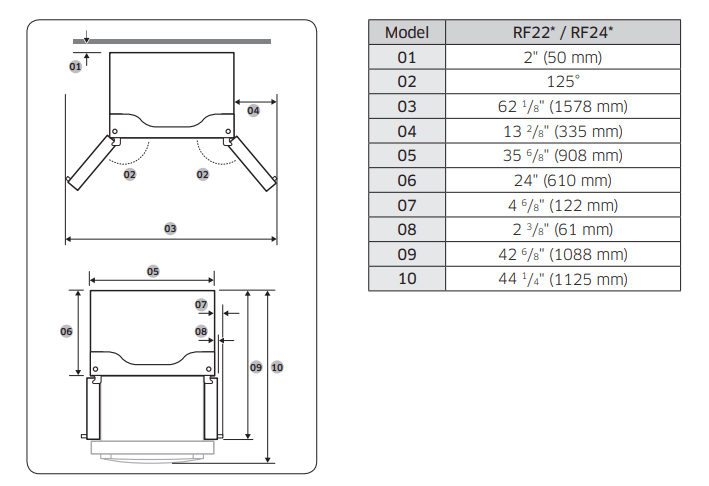
STEP 2 Flooring
If the refrigerator cannot pass through the entrance due to its size, see STEP 3 Door removal for entrance.

NOTE
To prevent floor damage, make sure the front levelling legs are in the upright position.
• The surface you install the refrigerator on must support a fully loaded refrigerator.
• To protect the floor, put a large piece of cardboard along the path to the refrigerator's final installation location.
• Once the refrigerator is in its final position, do not move it unless necessary to protect the floor. If you have to move the refrigerator, place thick paper or cloth such as old carpets along the path of movement.
STEP 3 Door removal for entrance
WARNING Unplug the power cord of the refrigerator before removing the doors
Tools required (not provided)
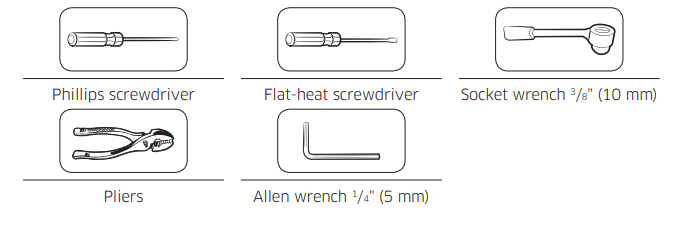
Detach the fridge doors
Left door
1. With the doors closed, use a Phillips head screwdriver to remove the screws (x3) in the top cover.

2. Disconnect the wires and the water tube from the left-side door. Do the following sequentially:
• Decouple the connector.
• While holding down one end of the water line coupler, disconnect the water tube.
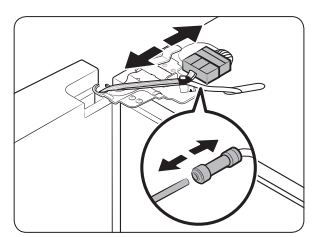
CAUTION Keep the water tube clips out of children’s reach.
3. Gently draw up the clamp in several steps. To prevent finger injuries, do not apply a sudden force to the clamp.
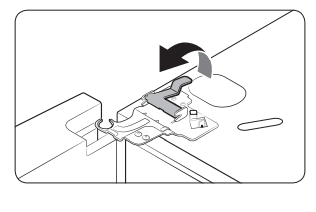
4. Pull up the clamp to remove it.
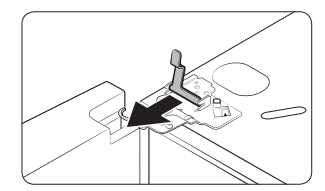
5. Open the door 90 degrees. While holding the door, pull up and remove the top hinge. Be careful not to damage the connector wires when you remove the hinge.
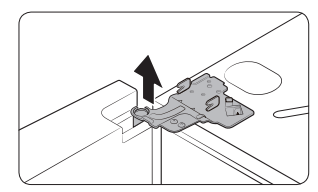
6. Gently pull up the door vertically to remove. Do not apply excessive force to the door. The door may fall, causing physical injury

7. Lay the door down on a flat surface.
CAUTION Please put the door down slowly to prevent scratches.
Right door
1. Disconnect the wire connectors (x2) on the right door. The position of the connectors differs with the model.
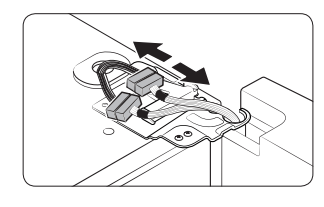
CAUTION
• Do not remove both doors simultaneously. Make sure to remove one door at a time. Otherwise, one of the doors may fall and cause physical injury.
• Make sure the refrigerator is off before disconnecting the connectors.
2. Gently draw up the clamp in several steps. To prevent finger injuries, do not apply a sudden force to the clamp.

3. Pull up the clamp to remove it.
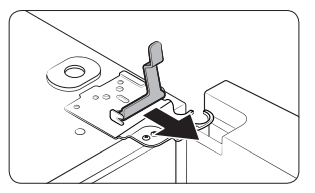
4. Open the door 90 degrees. While holding the door, pull up and remove the top hinge. Be careful not to damage the connector wires when you remove the hinge.

5. Gently pull up the door vertically to remove. Do not apply excessive force to the door. The door may fall, causing physical injury.
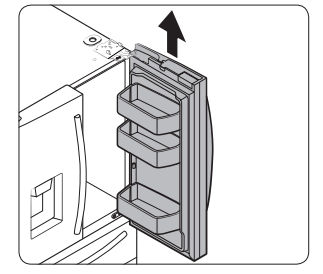
6. Lay the door down on a flat surface.
To reattach the fridge door
After you have moved the refrigerator to its final location, reattach the doors by following the removal instructions in reverse order.

01 Dispenser
02 Center of transparent coupler
03 Guidelines
CAUTION To prevent water leaks from the dispenser, the water line must be fully connected. Make sure both tubes of the water line are inserted fully to the center of transparent coupler (A) or the guidelines (B).
Detach the FlexZone™ drawer
1. Lift up to remove the FlexZone™ basket.
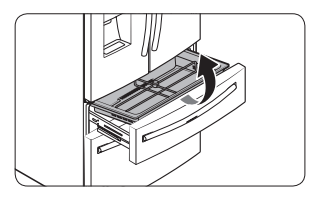
2. Remove the wire cover along with the connector harness using a flat-head screwdriver.

3. Press the locking tab to disconnect the wire connector.

4. Remove the hex-head bolt on each side of the drawer using a 10 mm socket wrench.
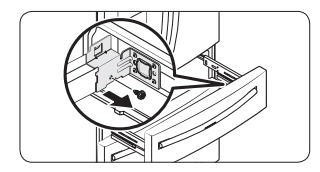
5. Lift up to remove the drawer front of the FlexZone™ from the rail assembly.
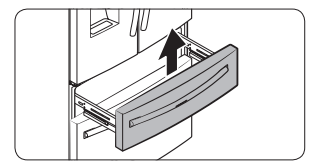
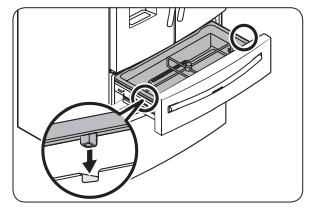
CAUTION
• Use caution when removing the rail assembly, which may fall off causing damage to the floor.
• Make sure to put the FlexZone™ drawer in place after removing or mounting the FlexZone™ basket. The FlexZone™ drawer may not open or close if the freezer drawer is not in place.
• Do not store too much food in the FlexZone™ drawer. This prevents the FlexZone™ drawer from closing properly, resulting in frost buildup.
To reattach the FlexZone™ drawer
After you have moved the refrigerator to its final location, re-attach the FlexZone™ drawer by following the removal instructions in reverse order.
To detach the freezer drawer
1. Push the upper basket to the end, and then pull up to remove.
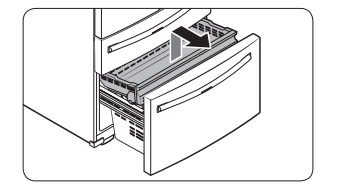
2. Then, pull up to remove the lower basket from the rail assembly.

3. Press down the hooks to unlock the rail assembly.

4. While holding the upper area of the freezer drawer front, slide the drawer out all the way to remove the freezer drawer from the rail assembly.
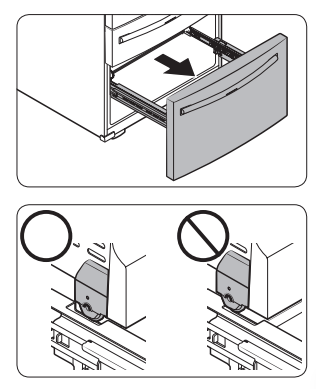
CAUTION
• Be careful not to scratch or dent the rail assembly.
• Make sure you mount the freezer baskets in the correct position. Otherwise, the door will not open or close properly, which causes frost to build up.
• Do not store too much food in the freezer drawer. This prevents the freezer drawer from closing properly, resulting in frost buildup.
To reattach the freezer drawer
Once the refrigerator is in or near it's final location, re-attach the freezer drawer by following the directions in the reverse order of removal.
STEP 4 Levelling the refrigerator
CAUTION.
• When installed, the refrigerator must be leveled on a flat, solid floor. Not leveling the refrigerator can cause damage to the refrigerator or physical injury.
• Levelling must be performed with the refrigerator empty. Make sure no food items are inside the refrigerator.
• For safety reasons, adjust the front a little higher than the rear.
Level the refrigerator using the special screws (levellers) on the front legs. Use a flat-head screwdriver to turn the revelers.
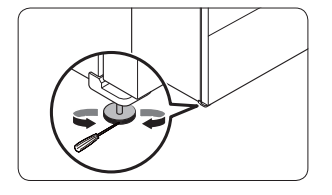
• To adjust the height of the left side: Insert a flat-head screwdriver into the leveller of the left side front leg. Turn the leveller clockwise to raise the left side or turn it counterclockwise to lower.
• To adjust the height of the right side: Insert a flat-head screwdriver into the leveller of the right side front leg. Turn the leveller clockwise to raise the right side or turn it counterclockwise to lower.
STEP 5 Adjust the door height and the door gap
Snap rings
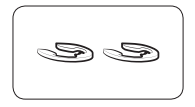
The height of a door can be adjusted using the provided snap rings, which come in 4 different sizes (1 mm, 1.5 mm, 2 mm, and 2.5 mm).
To adjust the height of a door
1. Check the height difference between the doors, and then lift up and hold the door with the lower height.

2. Insert a suitable-sized snap ring (A) between the door grommet (B) and the hinge as shown.
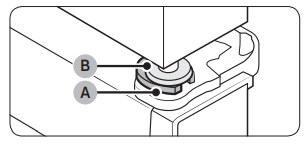
STEP 6 Attach the handles

CAUTION The refrigerator handles must be oriented in the correct direction.
• The fridge handles must be attached so that the holes on each face each other.
• The freezer handle must be attached so that its hole faces downwards.
1. Using a Phillips screwdriver, attach the handle screws to the refrigerator, two for each handle respectively, as shown in the illustration to the left.
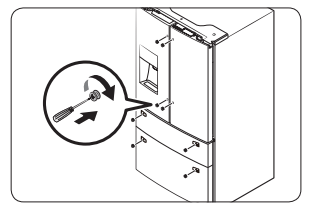
2. To attach the fridge handles to the refrigerator, first place the lower side of one handle onto the lower handle screw.
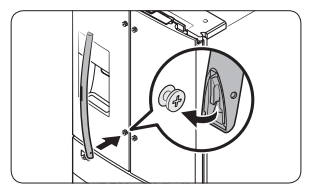
For type B handle: Attach the handle in the following order: (1) bottom, (2) middle, (3) top. Refer to the figure on the left.

3. Push the handle down, and then place the upper side of the handle onto the upper handle screw.

4. Insert the supplied wrench into the handle hole, and then turn it clockwise to tighten.
5. Repeat Steps 2 through 4 with the second refrigerator door handle.
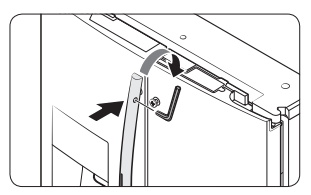
6. To attach the freezer handle to the refrigerator, first place the left side of the freezer handle onto the left handle screw.
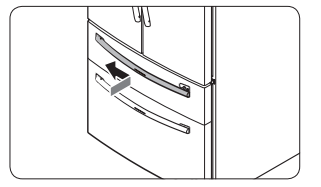
7. Push the handle to the left, and then place the right side of the freezer handle onto the right handle screw.

8. Insert the supplied wrench into the handle hole, and then turn it clockwise to tighten.

STEP 7 Connect the water dispenser line
1. Shut off the main water source.
2. Insert the pipe clamp (B) and the shutoff valve (C) into the cold water line (A).

3. Connect the water line installation kit (A) to the shutoff valve (B).

Connect the water supply line to the refrigerator

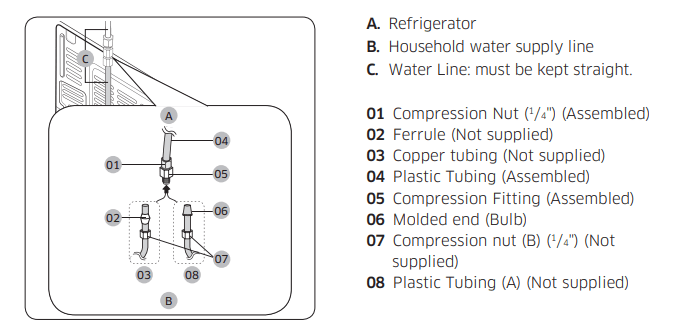
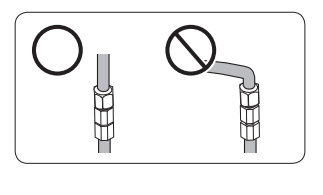
NOTE If you have to relocate the refrigerator after connecting the water line (C), make sure the joined section of the water line is straight.

CAUTION Do not mount the water filter on any part of the refrigerator. This may damage the refrigerator.
1. Connect the household water line to the assembled compression fitting.
- If you are using copper tubing, slip the compression nut (B) (not supplied) and ferrule (not supplied) on the copper tubing (not supplied) as shown.
- If you are using plastic tubing (A), insert the molded end (Bulb) of the plastic tubing (A) into the compression fitting.
2. Tighten the compression nut (B) onto the compression fitting. Do not over-tighten the compression nut (B).
3. Turn the water on and check for any leakage. If you find water drops or leakage in the connection areas, turn off the main water supply. Check the connections and, if necessary, tighten.
4. Flush 1 gallon of water through the filter before drinking or using the water from the refrigerator. (Flush approximately 6 minutes.) To flush, press a large glass or cup against the water dispenser lever. Fill the glass, empty it, and then repeat.
5. After you turn on the refrigerator, let the ice maker make ice for 1 to 2 days. Over that period of time, throw out the first 1 or 2 buckets of ice the ice maker makes to ensure all impurities have been removed from the water line
STEP 8 Initial settings
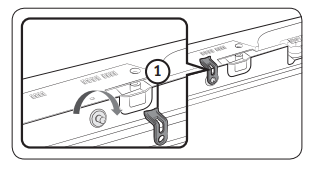
1. Plug the power cord into the wall socket to turn the refrigerator on.
2. Open the door, and check if the interior light lights up.
3. Set the temperature to the coldest setting, and wait for about an hour. Then, the freezer will be slightly chilled, and the motor should be running smoothly.
4. Wait until the refrigerator reaches the set temperature. Now the refrigerator is ready for use.
STEP 9 Final check
When installation is complete, confirm that:
• The refrigerator is plugged into an electrical outlet and grounded properly.
• The refrigerator is installed on a flat, level surface with a reasonable clearance from walls and cabinets.
• The refrigerator is level and is sitting firmly on the floor.
• The door opens and closes freely, and the interior light turns on automatically when you open the door.
Operations
Main panel
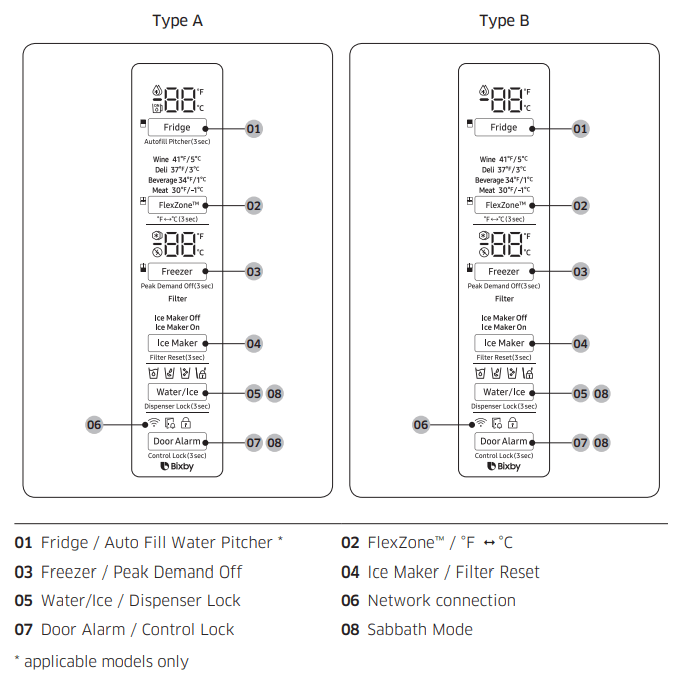
01 Fridge / Auto Fill Water Pitcher (3 sec)
| Fridge |
You can use the Fridge button to set the fridge temperature or to activate Power Cool. • Press Fridge repeatedly to select a desired temperature between 34 °F (1 °C) and 44 °F (7 °C). - The temperature indicator displays the currently set or selected temperature. • To activate Power Cool, press Fridge repeatedly until the Power Cool indicator - To deactivate Power Cool, simply press Fridge again while the Power Cool function is on. - Power Cool speeds up the cooling process at maximum power to lower the fridge temperature. The Power Cool process continues to run for several hours, and then turns off and the fridge returns to the previous temperature setting. - Use Power Cool to rapidly cool food that spoils quickly or to rapidly cool the refrigerator after the door has been left open for some time. |
| Auto Fill Water Pitcher |
If the Lock indicator ( ) is off, press and hold Fridge for 3 seconds to turn Auto Fill Water Pitcher on. Then, open the left door of the fridge and insert the water tank. Close the door and the water tank starts to fill with water up to the preset level. If the Lock Indicator ( ) is on, indicating Control Lock is active, press and hold Door Alarm for 3 seconds to deactivate Control Lock. When the Lock indicator goes out, immediately press and hold Fridge for 3 seconds to turn Auto Fill Water Pitcher on. Then, open the left door of the fridge and insert the water tank. Close the door and the water tank starts to fill with water up to the preset level. NOTE When you turn off Control Lock, you must press and hold Fridge within one minute or the Control Lock function will automatically reactivate. You cannot turn the Auto Fill Water Pitcher function on if Control Lock is active. For more information on Control Lock, see page 48. To turn the function off, press and hold Fridge again for 3 seconds. NOTE • By default, Auto Fill Water Pitcher is disabled. Enable this function after you have installed the water line. • If you open the door or push the dispenser lever, this function is stopped temporarily. • The Auto Fill Water Pitcher indicators blink if there is a leak. This may occur because the water tank overflows, or the water-line or water-level sensor fails. If this is the case, follow these steps. a. Open the rubber cap and drain water. b. When draining is complete, the indicators stop blinking and turn solid. c. Close the rubber cap. • If the indicators continue to blink, this might be a system failure. Contact a local service center. |
02 FlexZone™ / (3 sec)
(3 sec)
| Mode | Description | Examples |
| Wine | Select Wine to keep food fresh for a long time. The temperature of the FlexZone™ will be kept around 41 °F (5 °C). | Wine, cocktails, cake, cheese |
| Deli | Select Deli to keep food fresh for a longer time. The temperature of the FlexZone™ will be kept around 37 °F (3 °C). | Pineapples, lemons, biscuits, potatoes |
| Beverage |
Select Beverage to keep drinks cold and refreshing. The temperature of the FlexZone™ will be kept around 34 °F (1 °C). |
Bottled water, juice, soft drinks, beer |
| Meat |
Select Meat to keep meat or fish fresh for a longer time. The temperature of the FlexZone™ will be kept around 30 °F (-1 °C). |
Steaks, cold cuts, bacon, chili dogs |
CAUTION
• Do not use the FlexZone™ to store most kinds of fruit or leafy vegetables. These food items may suffer cold-temperature damage.
• Do not store glass bottles in the FlexZone™ in Beverage or Meat mode. They may break and cause physical injury.
|
|
You can also use the FlexZone™ button to switch the temperature scale between Celsius and Fahrenheit. To switch the temperature scale, press and hold FlexZone™ for 3 seconds to change the current temperature scale. |
03 Freezer / Peak Demand Off (3 sec)
| Freezer |
You can use the Freezer button to set the freezer temperature or to activate Power Freeze. • Press Freezer repeatedly to select a desired temperature between 5 °F (-15 °C) and -8 °F (-23 °C). - The temperature indicator displays the currently set or selected temperature. • To activate Power Freeze, press Freezer repeatedly until the Power Freeze indicator ( ) lights up. - To deactivate Power Freeze, simply press Freezer again while the Power Freeze function is on. - Power Freeze speeds up the freezing process at maximum power to lower the freezer temperature. The Power Freeze process continues to run for several hours, and then turns off and the freezer returns to the previous temperature setting. - To freeze large amounts of food, activate Power Freeze for at least 20 hours before putting the food in the freezer. |
| Peak Demand Off | The Peak Demand Off function activates/deactivates Smart Grid. (See Page 53) Press Freezer for 3 seconds to set/clear the Peak Demand Off function. |
04 Ice Maker / Filter Reset (3 sec)
| Ice Maker |
Press Ice Maker to turn the ice maker on or off. The ice maker has 2 indicators (Ice Maker On/Ice Maker Off) to indicate its operating status. • When the ice maker operates, the corresponding indicator (Ice maker on/Ice maker On ) turns on. • When the ice maker is turned off, the corresponding indicator ( Ice Maker Off) turns on. In this case, ice making is disabled even if you press the Cubed or Crushed Ice buttons on the dispenser panel. To enable ice making, you must turn the ice maker on. |
| Filter Reset |
After about 6 months (and typically, about 300 gallons (1200 L) of water), the Filter indicator blinks red for several seconds when you open the door, reminding you that the filter needs to be replaced. When this happens, replace the filter, and then press and hold Filter Reset for 3 seconds. The filter lifecycle will be reset and the Filter indicator turns off. |
05 Water/Ice / Dispenser Lock (3 sec)
| Water/Ice | You can dispense chilled water, cubed ice, or crushed ice. To dispense, press Water/Ice. The corresponding indicator turns on. |
| Dispenser Lock (Dispenser panel / Dispenser lever) |
To prevent use of the dispenser panel buttons and the dispenser lever, press and hold Water/Ice for more than 3 seconds. If you press and hold the button again for more than 3 seconds, the dispenser lock will be deactivated. NOTE .• The Dispenser Lock on the dispenser panel does not affect the controls on the main panel. To lock the main panel, use the Control Lock function on the main panel. • If you press Water/Ice for 3 seconds when both control lock and dispenser lock are active, you will deactivate both control lock and dispenser lock. |
06 Network connection
You can control and monitor your refrigerator on the SmartThings app. For more information, see the SmartThings section.
07 Door Alarm / Control Lock (3 sec)
| Door Alarm |
If the door is left open for more than 2 minutes, an alarm will sound and the alarm indicator will blink. You can toggle the alarm on and off by pressing Door Alarm. The alarm is enabled by factory default. If the door is left open for 5 minutes, internal lights (in the fridge, FlexZone™, and freezer) will blink for 10 seconds and then turn on. The whole process will be repeated every minute for 5 minutes. This is to alert hearing-impaired users that a door is open. Note that this function is normal. |
| Control Lock | To prevent accidental setting changes, press and hold Door Alarm for 3 seconds. The main panel will be disabled and the Lock indicator  will turn on. When Control Lock is on, the indicator blinks if any button on the main panel is pressed. If you press and hold the button again for more than 3 seconds, Control Lock will be deactivated. However, Control Lock will be reactivated if no button is pressed within 1 minute. will turn on. When Control Lock is on, the indicator blinks if any button on the main panel is pressed. If you press and hold the button again for more than 3 seconds, Control Lock will be deactivated. However, Control Lock will be reactivated if no button is pressed within 1 minute. |
08 Sabbath Mode
The Sabbath mode stays active for 85 hours once it is activated. After that, it will be deactivated automatically.
• To activate Sabbath Mode, press and hold Door Alarm and Water/Ice simultaneously for 5 seconds. When the refrigerator is in Sabbath mode, the buttons, the display, and the internal lights do not function. The refrigerator and freezer, however, continue to cool
. • To deactivate Sabbath Mode, press and hold Door Alarm and Water/Ice simultaneously again for 5 seconds.
09 Cooling Off
Cooling Off mode (also called Shop mode) is designed for use by retailers when they are displaying refrigerators on a retail floor.
In Cooling Off mode, the refrigerator’s fan motor and lights operate normally, but the compressors do not run so neither the refrigerator nor the freezer become cold. To enter or exit the Cooling Off mode, press and hold Fridge and FlexZone™ simultaneously for 6 seconds. Then, when the display blinks, press Door Alarm. When the Cooling Off mode is on, the refrigerator chime sounds, and the refrigerator shows “0” on the fridge temperature display and “FF” on the freezer temperature display.
SmartThings
Installation
Visit the Google Play Store, Galaxy Apps, or Apple App Store and search for “SmartThings”. Download and install the SmartThings app provided by Samsung Electronics to your smart device.
Samsung account
You are required to register your Samsung account to use the app. If you don’t have a Samsung account, follow the app’s onscreen instructions to create a free Samsung account.
Getting started
Turn on the device you want to connect, open the SmartThings app on your phone, and then follow the instructions below.
If a pop-up appears saying that a new device has been found, tap ADD NOW.
If a pop-up doesn't appear, tap the + button, and then select the device you want to connect from the list of available devices.
If your device isn't in the list of available devices, tap Supported Devices, select the device type (Refrigerator), and then select the specific device model. Follow the instructions in the app to set up your device. Once setup is complete, your refrigerator will appear as a "card" on your Devices screen.
Refrigerator app
Integrated control
You can monitor and control your refrigerator at home and on the go.
• Tap the refrigerator icon on the SmartThings Dashboard or tap the Devices icon at the bottom of the Dashboard, and then tap the refrigerator "card" to open the Refrigerator page.
• Check the operation status or notifications related to your refrigerator, and then change options or settings if necessary.
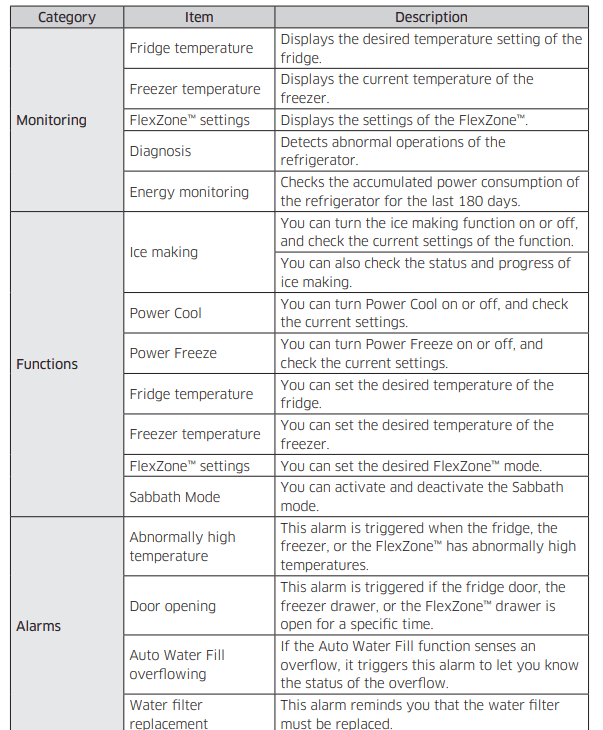
Dispenser panel

01 Water / Lock (3 sec)
| Water | To dispense chilled water, press Water. The corresponding indicator turns on. |
| Lock (Dispenser panel / Dispenser lever) | To prevent the use of the dispenser panel buttons and the dispenser lever, press and hold Water for more than 3 seconds. If you press and hold the button again for more than 3 seconds, the dispenser lock will be deactivated. When dispenser lock is on, the indicator blinks if any button on the dispenser panel is pressed or the dispenser lever is pressed. |
02 Cubed Ice
| Cubed Ice | Press Cubed Ice to dispense cubed ice. The corresponding indicator turns on. |
03 Crushed Ice
| Crushed Ice | Press Crushed Ice to dispense crushed ice. The corresponding indicator turns on. |
Special features
Water tank (Auto Water Fill) (applicable models only)

To fill the water tank
1. Grasp a handle groove of the sealed mouth, and then pull up to open the lid.
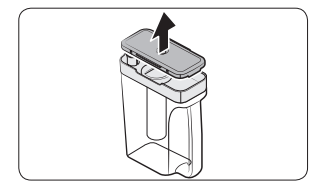
2. Put tea leaves or fruit to your taste into the infuser.
3. Enable the Auto Water Fill function on the main panel. Open the left door of the fridge door, and then mount the water tank onto the holder. Push it straight in as shown in the illustration on the left.

4. Close the door. The infuser will start to fill with chilled water a short time later.
5. To drink tea, open the door and detach the water tank. Pull it straight out.
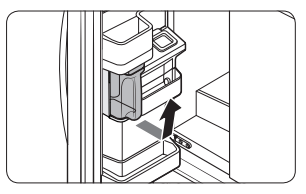
CAUTION
• We recommend consuming fruit infused water within 24 hours. After that, the infused water can spoil over time.
• You must clean the water tank after you have consumed the infused water. Also clean the water tank if you haven't used it for a long time.
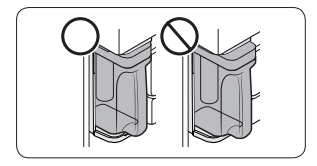
• To prevent the water tank from tipping over or leaking, make sure the water tank fits in the water tank holder.
• To prevent the water tank from spilling over or leaking, make sure the sealed mouth is properly inserted.
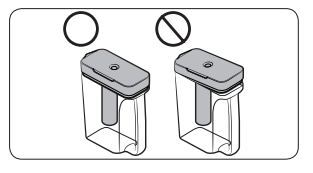
NOTE
• If the front side (specifically marked area) of the water tank has too much moisture, the water tank may not fully fill. Remove the moisture, and then try again.
• Auto Water Fill will stop supplying water to the water tank if the water tank does not fill after a certain amount of time. If this happens, check if the water line is properly connected. Remove and reinsert the water tank, and then try again.
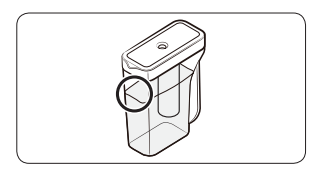
NOTE
• Wipe around the infuser holder if the infuser overflows or leaks.
• Water drops off if the rubber cap is opened.
• The Auto Water Fill indicator blinks if there is a leak. In case of a leak, open the rubber cap so that the leaked water drains. The indicator will then turn off. However, if the indicator continues to blink, there might be a system failure. Contact your local Samsung service center.
• The Auto Water Fill indicators blink if there is a leak. See page 42 for more information.
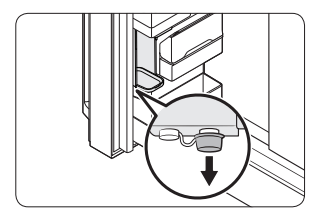
Water/Ice dispenser
To dispense water with ice
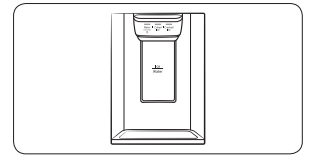
1. With the Ice Maker enabled, press Cubed Ice or Crushed Ice to select the ice type.
2. Put a water glass under the dispenser, and then push the dispenser lever with the glass. Ice will be dispensed from the dispenser.
3. Press Water to select water.
4. Push the dispenser lever with the glass. Water will be dispensed from the dispenser.
Ice maker
Ice making
After you have installed your refrigerator and plugged it in, follow these instructions to ensure proper ice making and to keep the ice bucket full of ice:
1. Let the refrigerator operate for at least 24 hours to ensure optimal performance.
2. Dispense the first 4 to 6 ice cubes into a glass.
3. Wait another 8 hours and dispense another 4 to 6 ice cubes.
4. Then, wait another 16 hours and dispense the first glass-full of ice.
Diagnosis
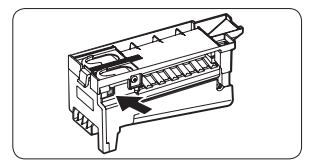
If ice does not dispense, first check the ice maker.
1. Press Test on the side of the ice maker. You will hear a chime (ding-dong) when you press the button.
2. You will hear another chime if the ice maker is operating properly.
If You Turn the Ice Maker Off
If you press and hold Ice Maker for more than 3 seconds to turn the ice maker off, make sure to remove all ice cubes from the ice bucket. Remaining ice cubes may clump together, making it difficult to remove them.
Water clouding
Water supplied to the refrigerator flows through a core alkaline filter. During this filtering process, the water pressure of the water increases and the water becomes saturated with oxygen and nitrogen. This causes the water to look misty or cloudy temporarily when dispensed. This is normal and the water will look clear after a few seconds.
FlexZone™ divider
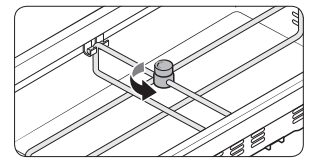
You can change the divider position. To do this, unlock the divider by turning the divider dial counter clockwise. Then, move the width and height bars as appropriate. When done, turn the dial clockwise to lock the divider.
Maintainance
Handling and care
Ice bucket (applicable models only)
If you do not dispense ice for an extended period, ice may form clumps inside the bucket. If this happens, remove and empty the ice bucket.
1. To remove the ice bucket, gently lift it up, and then pull it out slowly while holding the bottom of the bucket with one hand and the side with the other hand.
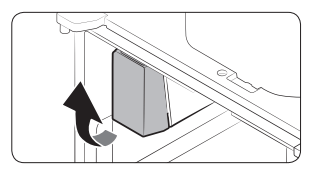
2. Empty the bucket
3. When done, put the bucket back into position. If the bucket does not fit in, turn the helix screw 90 degrees, and then try again.
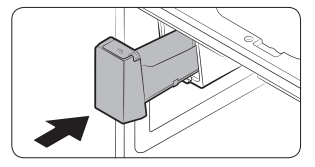
If the ice bucket is not firmly inserted, turn the Helix (A) 90 degrees, and then try again.

CAUTION
• Do not apply excessive force to the bucket cover. The cover may break.
• Do not forcefully close the door. Water may spill over the ice maker.
• To prevent injury, make sure to clean up any ice or water that has fallen on the floor.
• To prevent accidents or injury, do not let children play with the water dispenser or the ice maker.
• Do not put your hand or an object into the ice chute. This may cause physical injury or product damage.
• Use only the provided ice bucket. Third-party ice buckets may cause a system failure.
NOTE
• The water pressure required for ice making is between 20 psi and 125 psi (138 and 862 kPa). • Noise from the the ice maker as it produces ice during the ice making process is normal.
• While the door is open, neither the ice maker nor the water dispenser operates.
Auto Water Fill (applicable models only)
1. Grasp a handle groove of the sealed mouth, and then pull up to remove.
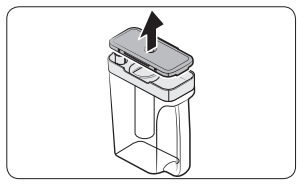
2. Grasp both sides of the sealed mouth, and then lift to remove.
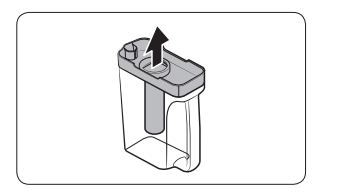
3. While slightly twisting the in
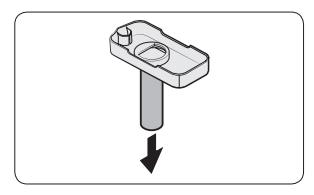
4. Clean the infuser with neutral agents and running water. Rinse and dry well.
5. Reassemble the Auto Water Fill in the reverse order of disassembly.
Fridge shelves
The appearance of the shelves differs by model.
• To remove a shelf, fully open the corresponding door. Hold the front of the shelf, and then gently lift up and slide out.

NOTE Do not lift up the shelf fully when removing or reinserting the shelf. The rear wall of the fridge room can be dented.
• To reinsert, hold the shelf at an angle so the front is higher than the back, and then insert the top hook into the top shelf notch. Then, lower the shelf and insert the bottom shelf hook into the bottom shelf notch.
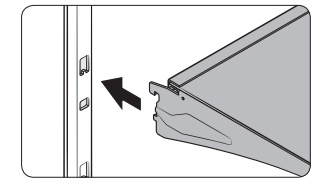
CAUTION
• The tempered glass shelves are heavy. Use caution when removing them.
• The shelf must be inserted correctly. Do not insert upside down.
• Glass containers may scratch the surface of glass shelves.
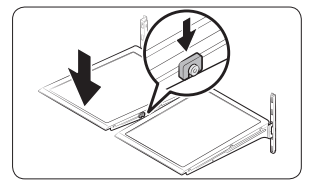
Foldable shelf
To remove, slide up the front of the shelf so that it folds. Then gently lift up and pull out. To reinsert, place the shelf on the angled frame in the main unit, and then, press down to unfold.
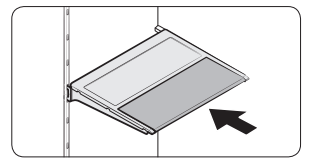
Recommended foldable shelf location
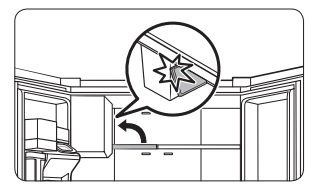
The foldable shelf folds up from the center, giving you more room for storage.
• Insert the shelf in the right side of the fridge. Left side insertion does not allow the shelf to fold completely.
• To fold, push the front area of the shelf inward so that it folds up from the middle.
Vegetable shelf
1. Slide out the left-side vegetable drawer.
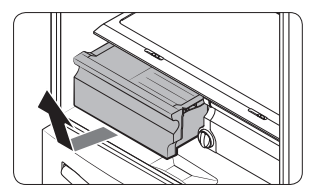
2. While supporting the vegetable shelf with one hand, slide it out with the other hand.
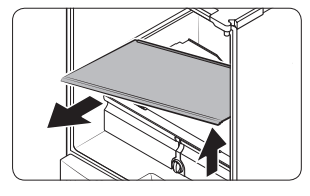
Door bins
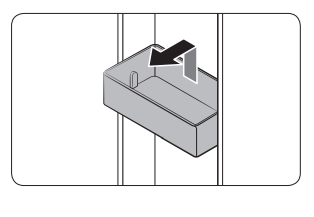
• To remove the top door bin, hold the front sides of the bin, and then gently lift up to remove.
• To reinsert, insert the door bin slightly above its final location making sure that the back of the bin is against the door. Hold the rear of the door bin with both hands, and then press down so that it fits snugly.

CAUTION
• Do not remove a bin that is filled with food. Empty the bin beforehand.
• Use caution when opening the door if the bottom bin contains larger bottles, which may fall over.
• Do not allow children to play with the bins. Sharp corners of the bin may cause injury.
Fridge drawers
Vegetable / fruit drawers

Gently lift up the front of the drawer and slide out.
• We recommend that you remove the door bins before removing the drawer. This is to prevent damage to the door bins.
• To reinsert, insert the drawer into the frame rails and then slide inward.
FlexZone™ basket
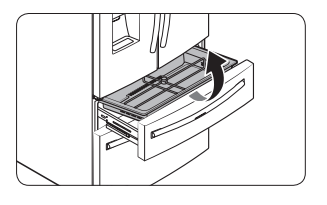
• To remove, fully open the FlexZone™ drawer. Lift up the FlexZone™ basket, and then pull out with both hands.
• To reinsert, fully open the FlexZone™ drawer. While tilting up the front of the basket, insert the rear of the basket into the rail assembly. Lower the front until the basket is in place.
• If the divider lock does not function, wipe the bars to remove moisture on them.
Freezer baskets
Upper basket
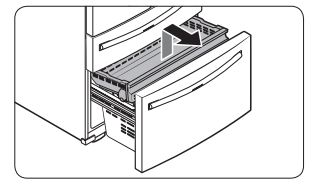
• To remove, fully slide open the freezer drawer. Push the upper basket to the end, and then pull up to remove.
• To reinsert, align the front wheels of the upper basket with the end of the lower basket. Slide the upper basket to the front.
Lower basket
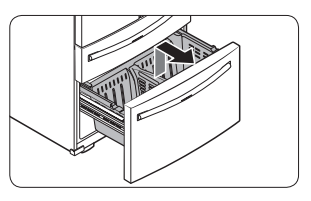
• To remove, first remove the upper basket. Then, tilt up the front of the lower basket to pull out.
• To reinsert, put the basket onto the rail assembly rear side first.
Freezer basket divider
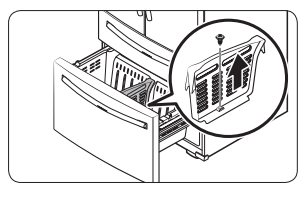
Loosen and remove the screw from the lower side of the divider. Then, pull straight up to remove the divider.
Cleaning
Interior and exterior
1. Unplug the power cord.
2. Use a moistened, soft, lint-free cloth or paper towel to clean the refrigerator’s interior and exterior.
3. When done, use a dry cloth or paper towel to dry well.
4. Plug in the power cord.
Ice / Water dispenser
CAUTION When crushed ice is selected, some residual ice chips may collect in the ice chute. To prevent this, remove the residual ice from the chute using a soft, clean cloth.
Rubber seals
If the rubber seals of a door become dirty, the door may not close properly and reducing refrigerator performance and efficiency. Use a mild detergent and damp cloth to clean the rubber seals. Then, dry well with a cloth.
Rear panel
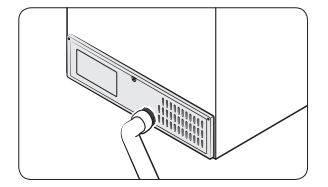
To keep cords and exposed parts of the rear panel free of dirt, vacuum the panel once or twice a year.
Replacement
Water filter
1. Shut off the water supply line.
2. Turn the knob of the filter cartridge counter clockwise 90 degrees (1/4 turn). The filter cartridge unlocks.
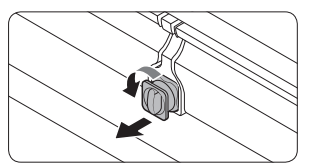
3. Pull out to remove the cartridge.
- If the water filter is severely contaminated, the cartridge may not be easy to remove. If that is the case, use force to remove the cartridge.
- To prevent water leaks from the filter opening, pull the cartridge straight out while removing it.
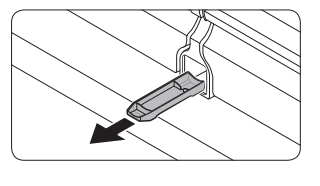
4. Insert a new filter cartridge. Use only Samsung-provided or approved filters.
5. Turn the cartridge knob clockwise to lock into place.
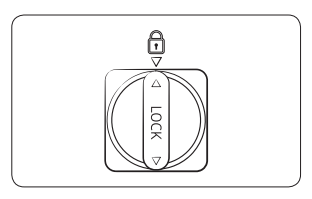
6. Press and hold Filter Reset on the main panel for 3 seconds to reset the life cycle detector. The Filter Reset indicator (Filter) turns off.
7. When you are done replacing the filter, open the water valve and run water through the dispenser for about 7 minutes. This is to remove impurities and air from the water line.
Reverse osmosis water filtration system
The water pressure of the water supply system to a reverse osmosis water filtration system must be between 35 psi and 120 psi (241 kPa and 827 kPa).
The water pressure of the reverse osmosis water filtration system to the refrigerator’s cold water line must be at least 40 psi (276 kPa). If the water pressure is below these specifications:
• Check if the sediment filter in the reverse osmosis system is blocked. Replace the filter if necessary.
• Refill the water tank in the reverse osmosis system with water
• If your refrigerator has a water filter, it may further reduce the water pressure when used in conjunction with a reverse osmosis system. Remove the water filter.
Ordering a new filter
To purchase a new water filter, contact a local Samsung service center or visit www. samsungparts.com on the web.
LED Lamps
To replace the lamps of the refrigerator, contact a local Samsung service center.
Troubleshooting
General
Temperature
| Symptom | Possible causes | Solution |
| Fridge/freezer does not operate. Fridge/freezer temperature is warm. | Power cord is not plugged in properly. | Properly plug in the power cord. |
| Power cord is not plugged in properly. | Set the temperature lower | |
| Refrigerator is located near a heat source or direct sunlight. | Keep the refrigerator away from direct sunlight or a heat source. | |
| Not enough clearance between refrigerator and nearby walls or cabinets. | Make sure there is a gap of at least 2.5 inches (5 cm) between the refrigerator back and sides and any nearby walls or cabinets. | |
| Energy Saver mode is activated. | Deactivate Energy Saver mode. | |
| The refrigerator is overloaded. Food is blocking | Do not overload the refrigerator. Do not allow food to block vents. | |
| Fridge/freezer is over-cooling. | Temperature control is not set correctly. | Set the temperature higher. |
| Interior wall is hot. | Refrigerator has heat-proof piping in the interior wall. |
To prevent condensation from forming, the refrigerator has heat-proof piping in the front corners. If the ambient temperature rises, this equipment may not work effectively. This is not a system failure.
|
Odors
| Symptom | Possible causes | Symptom Possible causes Solution |
| Refrigerator has odors. | Spoiled food. | Clean the refrigerator and remove any spoiled food. |
| Food with strong odors. | Make sure strong smelling food is wrapped airtight. |
Frost
| Symptom | Possible cause | Solution |
| Frost around the vents. | Food is blocking the vents. | Make sure no food blocks the refrigerator vents. |
| Frost on interior walls. | Door is not closed properly | Make sure food does not block the door. Clean the door gasket. |
| Fruits or vegetables are frozen. | Fruits or vegetables are stored in the FlexZone™. | Do not store most kinds of fruit or vegetables in the FlexZone™. |
Condensation
| Symptom | Possible causes | Solution |
| Condensation forms on the interior walls. | If door is left open, moisture enters the refrigerator. | Remove the moisture and do not leave a door open for extended periods of time. |
| Food with high moisture conten | Make sure food is wrapped airtight. |
Water/ice (dispenser models only)
| Symptom | Possible causes | Solution |
| Water flow is weaker than normal. | Water pressure is too low. | Make sure the water pressure is between 20 and 120 psi. |
| Ice maker makes a buzzing sound. | The ice maker function is activated, but the water supply to the refrigerator has not been connected. | Press Ice Maker |
| Ice maker does not make ice. | Ice maker has just been installed. | You must wait for 12 hours for the refrigerator to make ice. |
| Ice maker has just been installed. | Set the freezer temperature below 0 °F (-18 °C) or -4 °F (-20 °C) in warm ambient air. | |
| Dispenser panel Lock is activated. | Deactivate dispenser panel Lock | |
| Ice maker is off. | Turn on the ice maker. | |
| Ice does not dispense | Ice may jam if the ice dispenser is not used for a long time (approx. 3 weeks). | If you won't be using the refrigerator for a long time, empty the ice bucket and turn off the ice maker. |
| Ice bucket is not properly inserted. | Make sure the ice bucket is properly inserted. | |
| Water line is not connected properly or water supply is not on. |
Check if the water line is installed correctly. Check if the water line stop cock is closed.
|
|
| Water does not dispense | Water line is not connected properly or water supply is not on. |
Check if the water line is installed correctly. Check if the water line stop cock is closed.
|
| Dispenser panel Lock is activated. | Deactivate dispenser panel Lock. | |
| A third-party water filter was installed. |
Use only Samsung-provided or approved filters.. Unapproved filters may leak and damage the refrigerator. |
|
| Water filter indicator turns on or blinks. | Replace the water filter. After replacing, reset the filter indicator sensor. |
Do you hear abnormal sounds from the refrigerator?
These sounds are normal.
When starting or ending an operation, the refrigerator may make sounds similar to a car engine ignition. As the operation stabilizes, the sounds will decrease.

• While the fan is operating, these sounds may occur. When the refrigerator reaches the set temperature, the fan sound will stop.

• During a defrost cycle, water may drip on the defrost heater, causing sizzling sounds

• As the refrigerator cools or freezes, refrigerant gas moves through sealed pipes, causing bubbling sounds.

• As the refrigerator temperature increases or decreases, plastic parts contract and expand, creating knocking noises. These noises occur during the defrosting cycle or when electronic parts are working.

• For ice maker models: When the water valve opens to fill the ice maker, you may hear a buzzing sound.
• Due to pressure equalizing when you open and close the refrigerator door, you may hear a whooshing sound.
SmartThings
| Symptom | Action |
| Could not find “SmartThings” in the app market | • The SmartThings app is designed for Android 6.0 (Marshmallow) or later, iOS 10.0 or later, iPhone 6 or later, and is optimized for Samsung smartphones (Galaxy S and Galaxy Note series). |
| The SmartThings app fails to operate. |
• The SmartThings app is available for applicable models only. • The old Samsung Smart Refrigerator app cannot connect with Samsung Smart Home models. |
| The SmartThings app is installed but is not connected to my refrigerator. |
• You must log into your Samsung account to use the app. • Make sure that your router is operating normally. • If you have not connected your refrigerator to the SmartThings App after the app was installed, you must make the connection using the device registration function of the app. |
| Could not log into the app |
• You must log into your Samsung account to use the app. • If you don’t have a Samsung account, follow the app’s onscreen instructions to create one. |
| An error message appears when I try to register my refrigerator. | • Easy Connection may fail due to the distance from your access point (AP) or electrical interference from the surrounding environment. Wait a moment and try again. |
| The SmartThings app is successfully connected to my refrigerator but does not run. |
• Exit and restart the SmartThings app or disconnect and reconnect the router. • Unplug the power cord of the refrigerator, and then plug it in again after 1 minute. |
Smart Grid (applicable models only)
| Symptom | Action |
| What Do I Need to use the Energy Management and Smart Grid functions? |
To use the Smart Grid (Demand Response) and Energy Management functions on your refrigerator, you need the following: Devices • A wireless access point (router) • A Samsung Energy Management-supported refrigerator • A smartphone Registration • Connect your refrigerator to your home Wi-Fi network. • Register for the EMS service with your electric company. Your electric company must have an EMS (Energy Management System) supporting SEP (Smart Energy profile). App • Download the SmartThings app from the Google Play Store, Apple App Store, or Samsung Galaxy Apps. • Install and run the SmartThings app on your smartphone. |
| Why isn’t the Energy Management function working normally? |
Make sure that your home router is operating normally with proper Internet service and connection. • Make sure that the refrigerator is connected to the AP (router). Checkpoints • Connect your smartphone to the router (AP, Access Point), and then check if you can browse the Internet on the smartphone |
| Why isn’t the Delay Defrost Capability working normally? | Make sure that your home router is operating normally with proper Internet service and connection. |
See other models: RS25H5111SR/AA WA50M7450AP/A4 DVE50R5200W/A3 RF26HFENDWW/AA WA50R5200AW
 lights up.
lights up.
